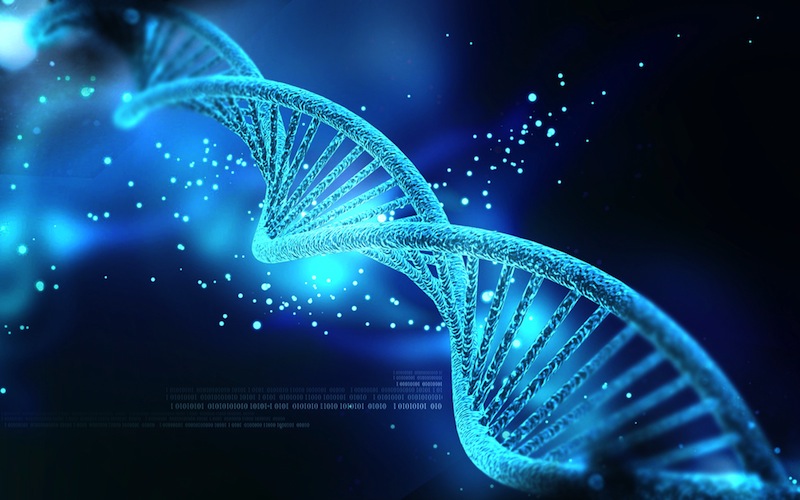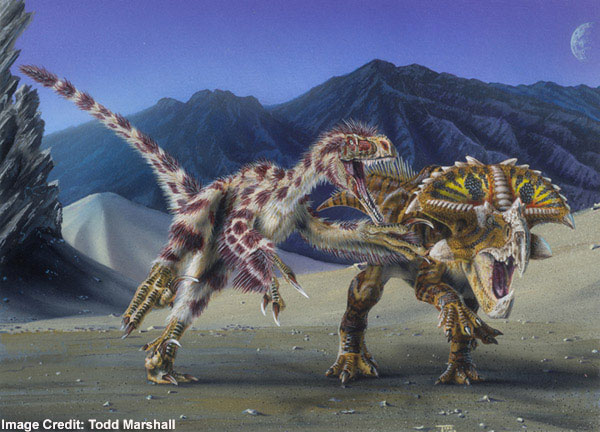Which Of The Following Is Not A Hindrance To Cloning Animals?
Is it possible to clone a dinosaur?
Apologies to people great on reviving extinct dinosaurs, but researchers have never recovered dinosaur Dna, which is necessary for cloning. But, intriguingly, they have establish fragments of mystery Dna in dinosaur bone, experts told Live Science.
It'due south unknown whether this Dna is dinosaurian, or whether it belongs to other life-forms, such as microbes; nondinosaurian animals, such equally earthworms; or even paleontologists who take worked with these fossils.
"I've found DNA in dinosaur bone," said Mary Schweitzer, a molecular paleontologist at North Carolina State University. "Merely we did not sequence it — we couldn't recover it, [and] we couldn't narrate information technology. Whoever it belongs to is a mystery."
Related: 6 extinct animals that could be resurrected
It'due south no surprise that dinosaur remains incorporate DNA, she said. Bone is partly made up of a mineral chosen hydroxyapatite, which has a potent affinity for certain biomolecules, including DNA. In fact, researchers ofttimes use hydroxyapatite to purify and concentrate DNA in the lab, Schweitzer said.
"That'southward one of the reasons that I don't work with Dna myself," Schweitzer told Alive Science. "Information technology is too decumbent to contagion and really hard to interpret."
Instead, Schweitzer analyzes dinosaur fossils for soft tissue, such as the blood vessels that she and her colleagues constitute in an 80-1000000-year-old duck-billed dinosaur. But she has still pondered the steps needed to clone an extinct dinosaur. Here is the scientific discipline information technology would take to create an actual "Jurassic Park" dinosaur, according to molecular experts.
How long can DNA survive?
Scientists need DNA to clone dinosaurs, but an organism's DNA starts decomposable the moment after that organism dies.
That's because enzymes (from soil microbes, body cells and gut cells) dethrone Dna. So does UV radiation. What'due south more, oxygen and water can chemically alter DNA, causing the strands to break, said Beth Shapiro, an associate professor in the Department of Ecology and Evolutionary Biological science at the University of California, Santa Cruz.
"All of these things will interruption downward the DNA into smaller and more degraded pieces, until somewhen, there is nothing left," Shapiro told Live Science.

The oldest recovered and authenticated DNA from bone belongs to a 700,000-twelvemonth-old equus caballus from the frozen Klondike gold fields in Yukon, Canada, said Shapiro, who co-wrote a 2013 study on information technology in the journal Nature.
Still, information technology's unclear just how long Deoxyribonucleic acid tin survive.
Scientists have proposed that DNA can survive every bit long as a million years, just definitely non more than 5 million or 6 1000000 years, Schweitzer said. That's woefully short of 65 one thousand thousand years ago, when the asteroid slammed into Earth and killed the nonavian dinosaurs.
However, more experiments are needed to make up one's mind how long, and in what atmospheric condition, DNA can survive, Schweitzer said.
Moreover, don't await a "Jurassic Park" twist to work. In the 1993 blockbuster, scientists detect dinosaur DNA in an ancient mosquito caught in bister. But amber, it turns out, does not preserve Dna well. Researchers tried to excerpt Deoxyribonucleic acid from two stingless bees preserved in copal, a forerunner of amber, in a 2013 study published in the periodical PLOS ONE.
The researchers couldn't find any "disarming evidence for the preservation of ancient DNA" in either of the two copal samples they studied, and they concluded that "DNA is not preserved in this blazon of cloth," they wrote in the study.
They added, "Our results heighten further doubts about claims of DNA extraction from fossil insects in amber, many millions of years older than copal."
Related: What if a giant asteroid had not wiped out the dinosaurs?
Dinosaur DNA?
If researchers cull to study the Deoxyribonucleic acid lurking in dinosaur bone, it will be hard to say whether it was dinosaurian in nature, the experts said.
"The DNA fragments that were recovered from that equus caballus bone were short (on average 40-ish letters long) and showed characteristic signs of postmortem damage," Shapiro told Alive Scientific discipline in an email. "But they could be mapped to the genome of a modern horse, and so we know that they were of horse origin."
In contrast, the dinosaurs' living relatives are birds. But birds evolved out of the theropod line — a group of bipedal, largely carnivorous dinosaurs such as Tyrannosaurus king and Velociraptor. Other dinosaur groups — including the hadrosaurs (the duck-billed dinosaurs), the ceratopsians (such as Triceratops), the stegosaurs and the ankylosaurs — practise not accept living relatives.
In addition, any surviving dinosaur DNA will be highly fragmented and badly damaged.
"Hither is a key problem with dinosaur Dna," Shapiro said. "I would then take to ask, 'Is this dinosaur Dna, or microbial Deoxyribonucleic acid that got into the dinosaur bone while it was cached in the soil?'"
Cloning adventures
For the sake of argument, let'south say that researchers constitute fully sequenced dinosaur Dna. This means that researchers would have an entire genome, including the so-called junk DNA and the viral DNA that'due south incorporated itself into the dinosaur'southward genetic code. This viral Dna could be a problem, specially if it could infect modern plants and animals, Schweitzer said.

Next, they'd have to find a host organism to help clone the beast. That would probable be a bird. Only a mother bird is a far weep from a mother dinosaur, Schweitzer said.
"There's more to developing a vertebrate organism than just what its DNA says," she said. "A lot of the timing is dictated by genes and proteins that the mother produces during evolution. How is it going to get the developmental signals that it needs?"
Over again, let's say that, somehow, the host mother was able to give birth to this animate being. The resulting offspring would be a half-bird, one-half-dinosaur cosmos, Schweitzer said. Simply could this animal survive in today'southward climate?
"Its genes and proteins survived in a very different world," she said. "The carbon dioxide content in the atmosphere was different; the oxygen content was different; the temperatures were unlike — how is information technology going to function [in the modern environs]?"
Moreover, the creature'southward digestive enzymes might non piece of work on modern animals and plants, and it wouldn't have Mesozoic microbes, which it probable would need to digest and blot nutrients, Schweitzer said.
"[Dinosaurs] were designed to break down dinosaur proteins," Schweitzer said. "Or [aboriginal] plants, if yous want to bring a plant eater dorsum, which I'd highly recommend."
Information technology would be vicious to bring back simply one dinosaur for our own amusement, she said. But it takes at least 5,000 animals to create a sustainable population with genetic diversity, Schweitzer said.
"How are you going to clone 5,000 T. rexes?" she asked. "And, if you could, where are you going to put them?"
There are so many problems researchers would have to overcome to clone a dinosaur, Schweitzer said. "Getting the Dna, which nosotros have not done — that would be the easy part," she said.
Notwithstanding, she plans to go on her studies on dinosaur os. And though cloning might be a pie-in-the-sky idea, she still thinks about it from time to time.
"To be honest, I'd actually similar to meet a T. rex," Schweitzer said. "Information technology would exist very cool."
Originally published on Alive Science.
Source: https://www.livescience.com/54574-can-we-clone-dinosaurs.html
Posted by: smoothitery.blogspot.com

0 Response to "Which Of The Following Is Not A Hindrance To Cloning Animals?"
Post a Comment